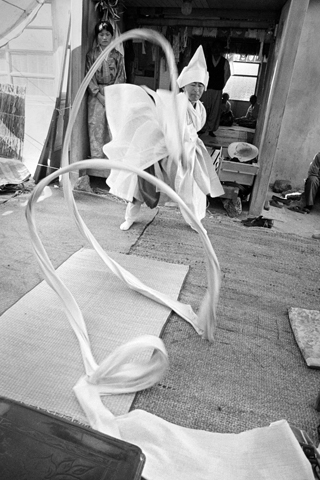Commemorating a photographer who loved shamanism

A photograph of a gut on Jeju Island, taken by the late Kim Soo-nam, shows the wishes of the living. [NATIONAL FOLK MUSEUM OF KOREA]
Especially from June 9 to 14, when the calendar shows that a gut, or traditional shaman ritual to comfort spirits, is scheduled in Gangneung, Gangwon. The Gangneung Danoje festival is held during the period of Dano, which starts on the fifth day of May on the lunar calendar.
“The Gangneung Danoje gut is Korea’s best town festival. If the date approaches near to Dano, my heart is filled with joy,” the late photographer Kim Soo-nam once said.
Kim (1949-2006) is well known for taking photos of religious ceremonies not only in Korea but abroad.
This year, Dano falls on June 9 on the solar calendar. The Gangneung Danoje festival was added to Unesco’s Representative List of Intangible Cultural Heritage of Humanity in 2005. Each year, the townspeople observe ancestral rites to pray for a peaceful and productive year.
Kim maybe also drop by to enjoy the festival in spirit, since he traveled all around the world when he was alive. He knows well that gut occupy the area between life and death.
Kim died while he was photographing the hill tribes in Chiang Rai Province, northern Thailand. He liked to say that a documentary photographer will be happy if he or she dies while reporting.
Gut is a mixture of arts. People pray for comfort and peace; they send off the dead and console the living. In the 1970s, gut was degraded to being seen as a mere superstition. Thus, the ritual gradually began to disappear. Kim felt sad about the situation that gut was in. So he picked up his camera to take photographs of any gut he could see.
Sometimes, shamans declined to be photographed. He wanted to be close to shamans so he danced with them and drank with them.
“I have only one wife, but I have more than 100 mothers-in-law,” Kim said. It was part of his effort to build intimate relationships.
He published 20 photographs of the “Korea’s Gut” series in 1993, which he took over 10 years.
A special exhibition of Kim’s work is being held at the National Folk Museum of Korea until June 6. It is meant to commemorate the 10th anniversary of his death. His bereaved family donated 170,000 pieces of Kim’s works to the museum. The photographs cover Kim’s work from the 1970s to the 2000s, depicting scenes of rituals worldwide. The exhibition contains the 100 works that best represent the photographer.
The exhibition deals with the common wish of humanity trying to escape the restraints of life and death. Kim believed that death is the beginning, and the end of life is death. The soul of Kim’s art is revived through photographs and video clips.
“This exhibition focuses on the universal theme of life and death, different from previous exhibitions of Kim that dealt with regional rituals and their cultures,” said Kim Hyung-joo, the curator of the exhibition.
BY PARK JEONG-HO
[kim.hyangmin@joongang.co.kr]










with the Korea JoongAng Daily
To write comments, please log in to one of the accounts.
Standards Board Policy (0/250자)